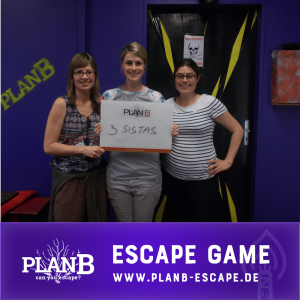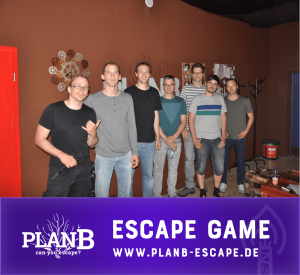4 STRATEGIES THAT WORK
Do the offered Escape Room puzzles keep your customers busy? Are there any relieved, happy “a-ha” moments when they are finally solved?
In the Live Escape game, do customers spend as much time laughing at the wrong tracks and cheering at the little successes as they do thinking and developing strategies?
No matter how new you are in the Escape Room business, you know that the quality of your puzzle is a critical factor for your success.
If you’re in the Escape Room business, hopefully, because you love puzzles too! The extra time it takes to ensure that customers experience an Escape Game adventure that will excite them is therefore child’s play.
Is it about making sure the Escape Rooms have the right balance of challenge and success rate? This article is intended to provide some tips for strategies that are essential for an authentic live escape game.
There are a few things that can make a person’s experience in an escape room a success or a failure:
- Number One: the environment
- Number two: the puzzles.
Especially the second point is of essential importance. There are so many factors involved in creating a perfect puzzle. The rule of thumb: A good puzzle is one that entertains and challenges visitors, but does not overwhelm them.
The visitors should have the feeling that they had a real chance to break out of the Escape Room and of course the visitors they solved should go home with a satisfied feeling at the end! That’s clear, isn’t it?
So here is some food for thought on how to design challenging puzzles for an Escape Room.
INSPIRATION
The perfect puzzle will not fall from the sky. It takes a lot of work to go beyond the obvious with a puzzle. Sometimes you start with an idea, which in the end produces a completely different result.
Many Escape Rooms fall into the trap of puzzles from a series of locks and combinations that could be interchangeable in any room and any theme. If that had been acceptable when Live Escape Games were new, the rapid growth of the Escape game industry alone would have required more: more creativity, more inspiration, more complexity.
The first step to creating a satisfying Escape Game is to look at the Escape Room and start thinking from there.
So you start with the theme of the Escape Room: Is it a cave? A doctor’s office? The cockpit of an airplane?
Let’s look at the example of the doctor’s office. Which elements are frequently found there? Stethoscopes, spatulas, cotton balls or needles, for example. Then try to go beyond the obvious.
The obvious variant would be to count the objects that are present in the escape room and try to use them as a numerical code for a lock or safe. What happens? People ravage the small glass containers on the counter and count everything just to find out that it’s not working.
What else? How about the stethoscope? A stethoscope is used to hear the heartbeat.
What happens if you use the stethoscope to hear a model heart?
You hear the beat, boom-boom, boom-boom, boom-boom.
The rhythm is the key to the right combination!
If players in the Live Escape game were confronted with a safe in this example, the first reflex would still be to look for numbers. But if they don’t find any obvious numbers, that’s when their creative potential is unleashed.
You don’t need to reinvent the Escape Game. It’s enough to reinterpret the elements in the Escape Room that people already know from previous games as solution elements.
In addition to numerical and other cognitive puzzles, it is also worth stimulating the senses of the participants in the Live Escape Room.
Testing the grey cells is one thing. When you include senses like smell, touch, or taste in the Live Escape game, you take the players to a whole new level – a higher Escape Game dimension, so to speak.
Escape gamers sniff at different vials in the office to get to the next step. Or they could look in a part of the Escape Room where there is a certain sound or draught.
There is no formula for the perfect escape game, but a simple scheme to illustrate the approach to a live escape game could look like this:
Theme ? Object ? interaction ? Interaction ? Goal
First look at the topic, and then think of the players. How do they see your object?
Then how can you get them to see the object the way you want it?
If you use the general knowledge of an article against the article itself, you will get a guaranteed good twist for the Escape Room.
MANAGING DIFFICULTIES
After considering the alternative uses for the items in the Escape Room, the next step is to consider how difficult it is to successfully complete the Escape Game.
The choice is between 2 extremes: Quality and quantity. Either some really challenging puzzles or a higher number of slightly easier puzzles.
Of course, this decision depends heavily on whether the Escape Room is aimed at the general public or at live escape game professionals.
In the Escape Game, which is aimed at the general public, the second variant with simpler puzzles, which even beginners can solve after an attempt and error, is the recommended one.
Because for beginners in Live Escape Game the danger is that they can quickly be overwhelmed by overly complicated puzzles.
Another important factor is the time limit.
It is important to test the puzzles in the Escape Room to ensure that the participants of the Live Escape Game have a chance to master the Escape Room before the clock runs out.
It should be ensured that the puzzles are not too demanding and that there are not too many puzzles to escape within the given time limit. Finding a healthy balance between the two poles can be difficult, but it becomes easier as more players watch them successfully make their way through the Escape Room.
Another important consideration is how many people the room is designed for. Of course, with more players, you will be able to solve more challenging puzzles because you can work together.
So it’s essential to motivate the participants of the escape game to work as a team to solve the puzzles. Otherwise, there is a danger that the other players in the Escape Game with more dominant personalities will solve all the puzzles.
THE STRUCTURE OF THE PUZZLES
One way to compensate for the above tendency of some people to have control is to create the space and the puzzles in a non-linear plot.
So one puzzle should not lead to the next and the next and so on. The room should offer several puzzles at once in different areas, which the participants can complete in groups.
Creating puzzles of this kind can be difficult, but there is nothing worse in an escape room than someone standing around and getting bored while everyone else is having fun. Providing parallel ways to solve puzzles helps to involve participants who might otherwise be more passive.
In addition, the creation of different puzzle hotspots creates more roles that participants need to work as a team.
Let’s return to the medical practice, for example: in this Escape Room, a group might be looking for a file inside the computer or in a filing cabinet, while two or three other participants in the Escape Game turn to the safe with the stethoscope. In this way, the two groups can be on opposite sides of the room, and each has a role to play.
MAKE NEW
What we mean is changes the puzzles within the escape rooms from time to time.
Redesigning an escape room can seem a little intimidating, especially after you’ve already put all that effort into a first version. However, it is important when participants of an escape game want to drop by again and be challenged. It also prevents participants from passing on the solution to certain puzzles to other participants and depriving them of the fun of the live escape game.
The good news is that after creating and analyzing the puzzles in an Escape Room, it is easier to know the difficult and less difficult puzzles and develop a sense of what could improve the Escape Room. Even observing the participants – for example, how they explore the Escape Room during the course of their Escape Game – can provide clues for new ideas.
Customer feedback will also be a long way in helping you design future challenges and puzzles.
It might help to get back to number one with what you have observed and keep any feedback in mind when considering how objects can be used differently.
Let’s go back to the doctor’s office, for example, one way to innovate would be, instead of opening the safe with a stethoscope, to place it on the wall to hear a secret message.
There are so many ways to innovate and adapt the elements in an escape room – or just add new elements.
OTHER CONSIDERATIONS
The goal in designing an Escape Room should be to provide participants with a leisure activity that requires thought, discussion, trial, and error before it can be solved.
If participants can solve the challenge by guessing rather than by investigating, there is something wrong with the design of the Escape game.
Because a live escape game that can be solved by luck, rather than by consistent and coherent thought, contradicts the purpose of an escape room.
When players in the Escape Room solve a puzzle by guessing it, they lose the sense of fulfillment and progress that comes from gradually solving the various puzzles.
In essence, players will leave the Escape Room without having developed an understanding of the activities they have carried out and how the various elements and puzzles have influenced each other reciprocally.
You should also consider the different abilities of visitors.
Beware of puzzles that can be ambiguous. Puzzles should be able to be solved with what is available in the Escape Room.
Dealing with the themes and objects in the Escape Game are the tools that the participants have to successfully pass the Escape Room. Using facts outside the Escape Room for a puzzle implies the danger of encountering a group that has no chance of solving the puzzle.
WHAT HAPPENS THEN?
The ideas in this article are just that: ideas. The type of puzzles in the Escape Room depends on how experienced the players are, how much time the teams have to solve the puzzles, and how many people are allowed in each Escape Room. So it’s important to remember that not every puzzle you design will work as planned.
An escape game that you have designed to be simple could be more difficult and vice versa. The best way to know which puzzles succeeded and which ones didn’t is for people to try them out. People like friends, family, or colleagues test the Escape Room and can already give you a good idea of how easy or difficult the designed Live Escape Game is.
You may have to adapt to the different challenges over time, and that’s okay!
It’s important to pay attention to different groups as they try out different Escape Room puzzles.
You should also make sure that you get feedback after the Escape Game in order to get new ideas and inspiration or to find areas that can be improved.
When asked how to create exciting Escape Game puzzles, the best answer is: Just start designing. Then review and customize. You should design several puzzles for one object. Maybe the right solution is a combination. The most important thing first of all is to simply develop puzzles.
Develop and test; then adapt and test and adapt again.








